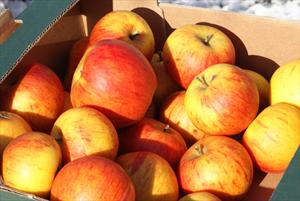One of the great advantages of apples over other orchard fruits is that many of them can be stored for use after harvest. However storing apples needs careful planning and not all apples can be stored.

Apple ripening and picking seasons
The time of ripening is a good indicator of the storage potential of an apple variety.
Early-season apples
Very early season apples generally do not keep at all. They should really be eaten straight off the tree. The best way to extend the eating season is to pick them regularly from the tree over the course of a week or so, and then eat them straightaway.
Mid-season apples
Mid-season apples will usually keep for 2-3 weeks. The best way to keep them fresh is to put 5-10 of them in a polythene bag, make a few air-holes, and store them in a refrigerator. They will not keep anything like as long at room temperature.
As with early apples, there is a lot to be said for leaving the apples on the tree and eating them as you go.
Late-season apples
Late-season apples usually keep the longest. Most can be stored in a cold place at least until Christmas, and a good number of varieties will keep in the right conditions well into the new year.
There is no obvious rule of thumb for which varieties will store best, although you can sometimes assume that the later a variety ripens the longer it will keep - Fuji, Braeburn, Granny Smith being good examples. Varieties related to Golden Delicious such as Gala are also likely to keep well. Many traditional cooking apples also keep well, since in the days before refrigeration this was an important quality in a cooking apple.
Not all late-season varieties are keepers. Varieties related to McIntosh (Spartan, Cortland) lose their flavor quite rapidly if you keep them even though they do have quite a long-storage life - these varieties are best treated as mid-season apples.
Storing your apples - managing expectations
Commercial apple suppliers have sophisticated constant temperature management, humidity management, and controlled atmosphere (CA) storage which uses carbon dioxide gas to help delay ripening. They also mix supplies from the southern and northern hemispheres in season. As a result we are used to being able to eat fresh apples almost year-round. However these techniques are not usually possible in a domestic situation.
Previous generations probably also had lower expectations of the quality of stored apples, and would have eaten apples that the modern consumer might not feel were acceptable. Also, today we expect to be able to eat apples fresh, whereas in the past stored apples were primarily used for cooking (although there are several good traditional dessert apples which will store well).
Finally, daytime temperatures during October (when most late-season apples ripen) can still be quite warm compared to what they might have been a century ago. This means that if you are relying on the traditional cold barn or shed to store your apples, you may find temperatures are not cold enough and the apples may ripen and go off before you can use them. For this reason it is almost certain that you will need a fridge, at least for the first month or so, if you are to be successful in keeping apples for the winter.
How to store apples for the winter
Bearing the above in mind, here are some suggestions to help you pick your apples and store them for the winter.
Only choose varieties that are known to store well.
If you are picking with the intention of storing your apples, it is best to pick them slightly under-ripe. If they are ripe when you pick them they are more likely to become over-ripe during storage.
Pick the apples first thing in the morning, when they are still cool from overnight.
Remove any that are damaged, especially bruised apples.
If daytime temperatures are still warm, you will have to put the apples in a fridge until winter temperatures arrive. Once average temperatures fall to just above freezing you can move them to a frost free shed or garage. If storing apples in a fridge, put them in polythene bags, 5-10 to a bag, and make a few air-holes. This helps air circulation and counteracts the dry air found in a fridge.
Once daytime temperatures fall to just above freezing then you can store the apples in a frost-free shed or garage. The storage location must be cold, but frost-free because if the apples freeze they will become unusable.
Apples are best stored on trays in traditional wooden boxes, seed trays, or cardboard boxes - the most important thing is good air circulation and ventilation, and humidity. Try a mix of storage materials (including keeping some apples in polythene bags) as some methods may work better than others in your situation. Some authorities recommend wrapping each apple loosely in newspaper.
Check the apples regularly and remove any that are going off.
When using the apples over the winter, start with the larger ones (for any given variety) as the smaller ones tend to keep longer.
The best apples for winter storage
Our variety listings include a filter to let you select apple varieties which keep well.
